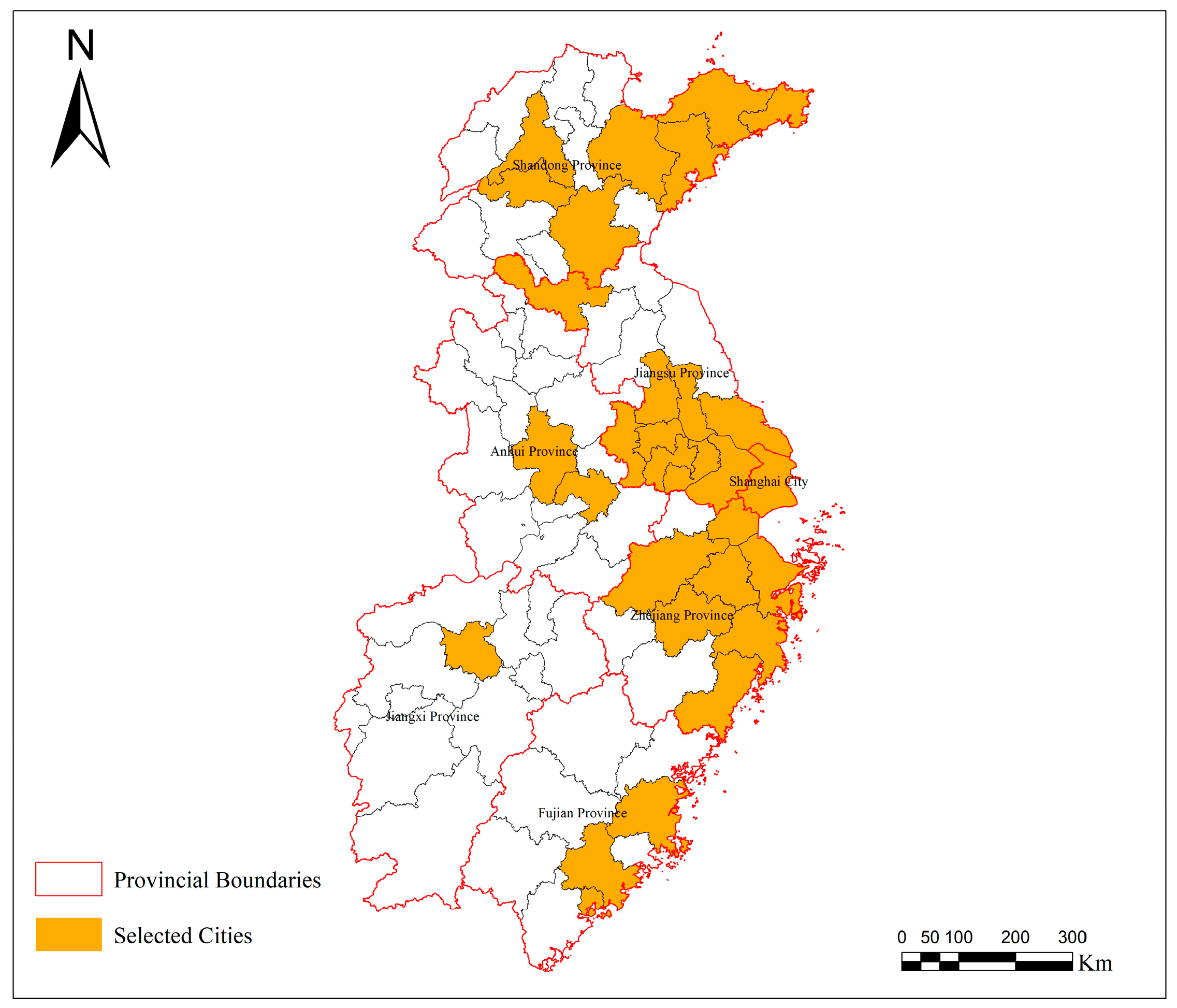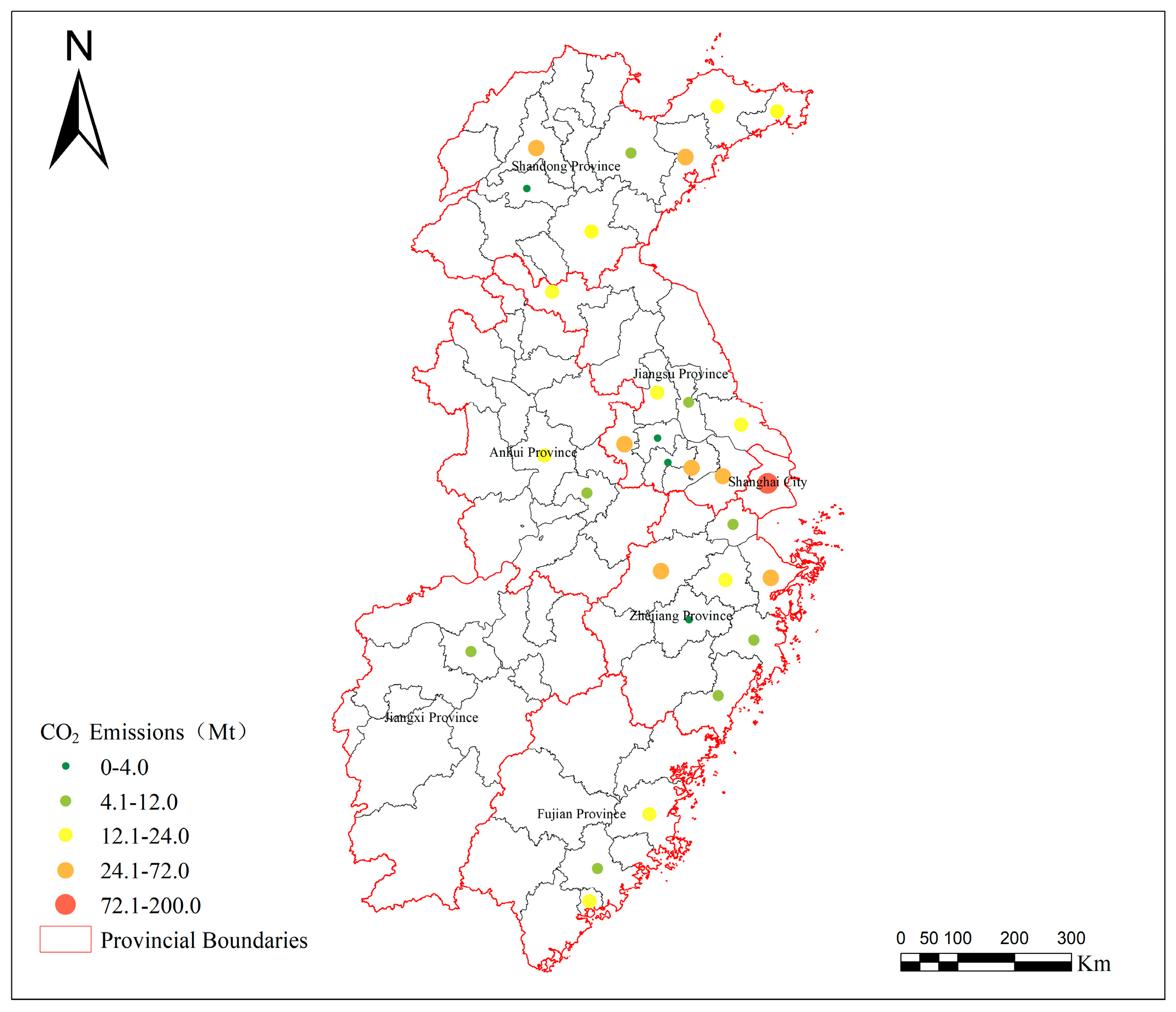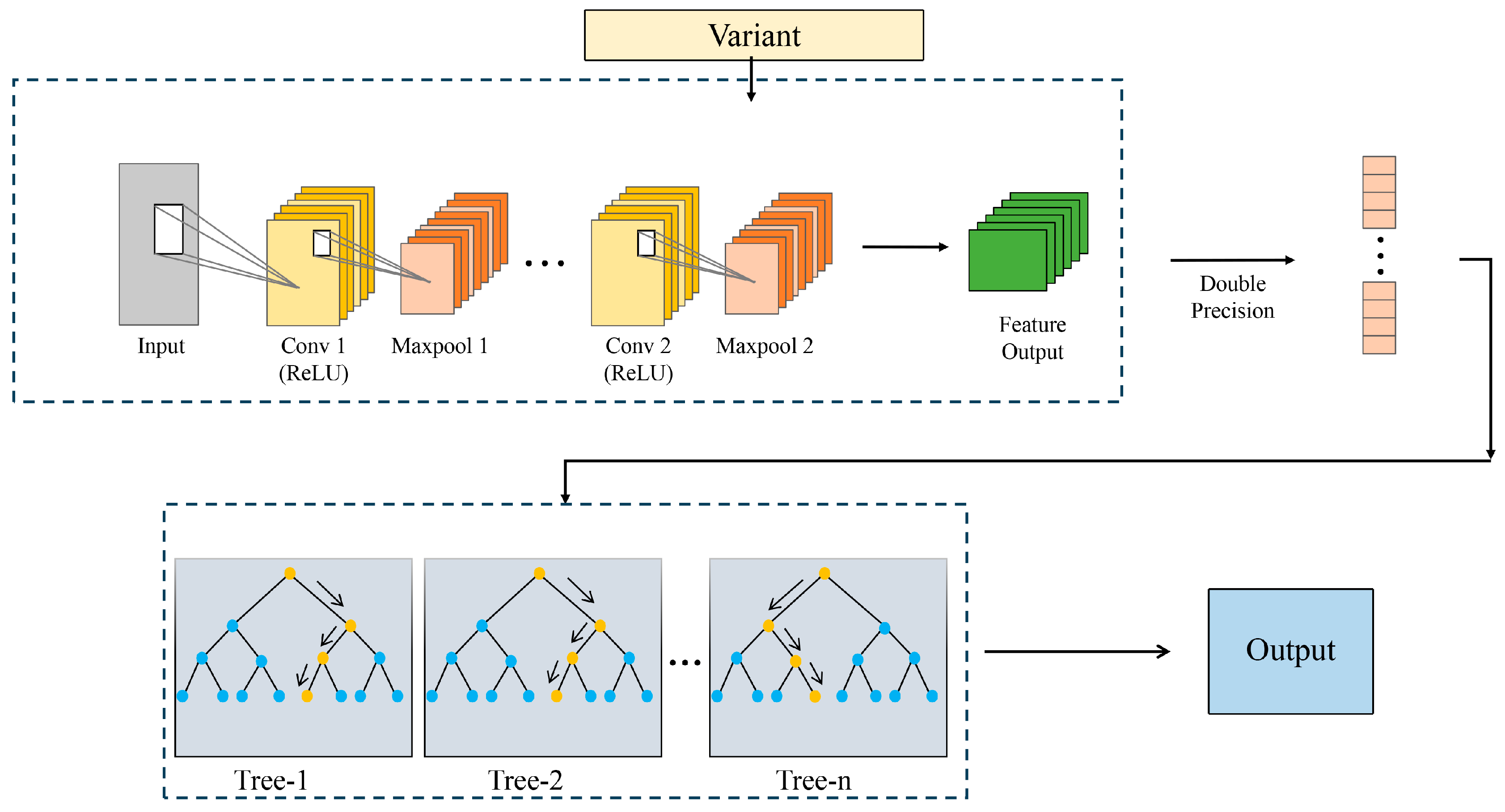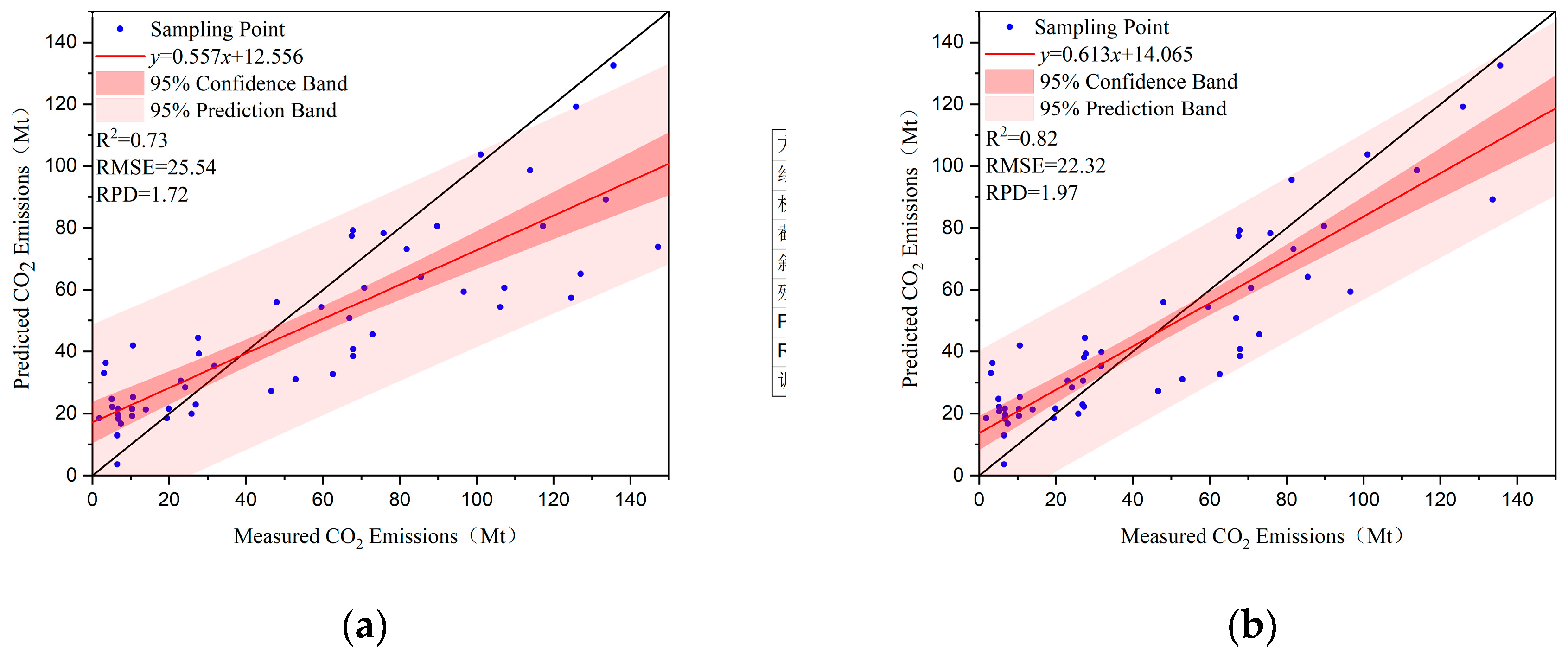The Relationship Between Three-Dimensional Spatial Structure and CO2 Emission of Urban Agglomerations Based on CNN-RF Modeling: A Case Study in East China
Abstract
:1. Introduction
2. Materials and Methods
2.1. Study Area
2.2. Data
2.3. Quantification of Urban Three-Dimensional Spatial Structure
2.4. Data Preprocessing
2.5. Methodologies
2.5.1. Backpropagation Neural Network (BP)
2.5.2. Random Forest (RF)
2.5.3. Convolutional Neural Network (CNN)
2.5.4. Convolutional Neural Network–Random Forest (CNN-RF)
2.6. Model Evaluation
2.7. Model Building
3. Results
3.1. Relevant Analysis
3.2. Variable Analysis
3.3. Model Analysis
4. Discussion
4.1. Comparative Analysis of Models
4.2. Impact of Three-Dimensional Spatial Structure on CO2 Emissions
5. Conclusions
Author Contributions
Funding
Institutional Review Board Statement
Informed Consent Statement
Data Availability Statement
Conflicts of Interest
References
- Silva, M.; Oliveira, V.; Leal, V. Urban Form and Energy Demand. J. Plan. Lit. 2017, 32, 346–365. [Google Scholar] [CrossRef]
- Cai, B.; Liang, S.; Zhou, J.; Wang, J.; Cao, L.; Qu, S.; Xu, M.; Yang, Z. China high resolution emission database (CHRED) with point emission sources, gridded emission data, and supplementary socioeconomic data. Resour. Conserv. Recycl. 2018, 129, 232–239. [Google Scholar] [CrossRef]
- Wang, S.; Liu, X. China’s city-level energy-related CO2 emissions: Spatiotemporal patterns and driving forces. Appl. Energy 2017, 200, 204–214. [Google Scholar] [CrossRef]
- Wang, S.; Liu, X.; Zhou, C.; Hu, J.; Ou, J. Examining the impacts of socioeconomic factors, urban form, and transportation networks on CO2 emissions in China’s megacities. Appl. Energy 2017, 185, 189–200. [Google Scholar] [CrossRef]
- Wakiyama, T.; Zusman, E. The impact of electricity market reform and subnational climate policy on carbon dioxide emissions across the United States: A path analysis. Renew. Sustain. Energy Rev. 2021, 149, 111337. [Google Scholar] [CrossRef]
- Fan, T.; Chapman, A. Policy Driven Compact Cities: Toward Clarifying the Effect of Compact Cities on Carbon Emissions. Sustainability 2022, 14, 12634. [Google Scholar] [CrossRef]
- Ribeiro, H.V.; Rybski, D.; Kropp, J.P. Effects of changing population or density on urban carbon dioxide emissions. Nat. Commun. 2019, 10, 3204. [Google Scholar] [CrossRef] [PubMed]
- Domon, S.; Hirota, M.; Kono, T.; Managi, S.; Matsuki, Y. The long-run effects of congestion tolls, carbon tax, and land use regulations on urban CO2 emissions. Reg. Sci. Urban Econ. 2022, 92, 103750. [Google Scholar] [CrossRef]
- Tang, J.; Gong, R.; Wang, H.; Liu, Y. Scenario analysis of transportation carbon emissions in China based on machine learning and deep neural network models. Environ. Res. Lett. 2023, 18, 064018. [Google Scholar] [CrossRef]
- Luna, T.F.; Uriona-Maldonado, M.; Silva, M.E.; Vaz, C.R. The influence of e-carsharing schemes on electric vehicle adoption and carbon emissions: An emerging economy study. Transp. Res. Part D Transp. Environ. 2020, 79, 102226. [Google Scholar] [CrossRef]
- Li, Z.; Wang, F.; Kang, T.; Wang, C.; Chen, X.; Miao, Z.; Zhang, L.; Ye, Y.; Zhang, H. Exploring differentiated impacts of socioeconomic factors and urban forms on city-level CO2 emissions in China: Spatial heterogeneity and varying importance levels. Sustain. Cities Soc. 2022, 84, 104028. [Google Scholar] [CrossRef]
- Shahbaz, M.; Nasir, M.A.; Hille, E.; Mahalik, M.K. UK’s net-zero carbon emissions target: Investigating the potential role of economic growth, financial development, and R&D expenditures based on historical data (1870–2017). Technol. Forecast. Soc. Chang. 2020, 161, 120255. [Google Scholar] [CrossRef]
- Hailemariam, A.; Dzhumashev, R.; Shahbaz, M. Carbon emissions, income inequality and economic development. Empir. Econ. 2019, 59, 1139–1159. [Google Scholar] [CrossRef]
- Hong, S.; Hui, E.C.-M.; Lin, Y. Relationship between urban spatial structure and carbon emissions: A literature review. Ecol. Indic. 2022, 144, 109456. [Google Scholar] [CrossRef]
- Lu, X.; Zhang, Y.; Li, J.; Duan, K. Measuring the urban land use efficiency of three urban agglomerations in China under carbon emissions. Environ. Sci. Pollut. Res. 2022, 29, 36443–36474. [Google Scholar] [CrossRef]
- Sarkodie, S.A.; Owusu, P.A.; Leirvik, T. Global effect of urban sprawl, industrialization, trade and economic development on carbon dioxide emissions. Environ. Res. Lett. 2020, 15, 034049. [Google Scholar] [CrossRef]
- Wu, Y.; Li, C.; Shi, K.; Liu, S.; Chang, Z. Exploring the effect of urban sprawl on carbon dioxide emissions: An urban sprawl model analysis from remotely sensed nighttime light data. Environ. Impact Assess. Rev. 2022, 93, 106731. [Google Scholar] [CrossRef]
- Sufyanullah, K.; Ahmad, K.A.; Sufyan Ali, M.A. Does emission of carbon dioxide is impacted by urbanization? An empirical study of urbanization, energy consumption, economic growth and carbon emissions—Using ARDL bound testing approach. Energy Policy 2022, 164, 112908. [Google Scholar] [CrossRef]
- Hanif, I. Impact of fossil fuels energy consumption, energy policies, and urban sprawl on carbon emissions in East Asia and the Pacific: A panel investigation. Energy Strategy Rev. 2018, 21, 16–24. [Google Scholar] [CrossRef]
- Ding, S.; Liu, S.; Chang, M.; Lin, H.; Lv, T.; Zhang, Y.; Zeng, C. Spatial Optimization of Land Use Pattern toward Carbon Mitigation Targets—A Study in Guangzhou. Land 2023, 12, 1903. [Google Scholar] [CrossRef]
- Xia, C.; Zhang, J.; Zhao, J.; Xue, F.; Li, Q.; Fang, K.; Shao, Z.; Zhang, J.; Li, S.; Zhou, J. Exploring potential of urban land-use management on carbon emissions—A case of Hangzhou, China. Ecol. Indic. 2023, 146, 109902. [Google Scholar] [CrossRef]
- Wang, G.; Han, Q.; de Vries, B. The multi-objective spatial optimization of urban land use based on low-carbon city planning. Ecol. Indic. 2021, 125, 107540. [Google Scholar] [CrossRef]
- Wang, X.; Cai, Y.; Liu, G.; Zhang, M.; Bai, Y.; Zhang, F. Carbon emission accounting and spatial distribution of industrial entities in Beijing—Combining nighttime light data and urban functional areas. Ecol. Inform. 2022, 70, 101759. [Google Scholar] [CrossRef]
- Zheng, Y.; Du, S.; Zhang, X.; Bai, L.; Wang, H. Estimating carbon emissions in urban functional zones using multi-source data: A case study in Beijing. Build. Environ. 2022, 212, 108804. [Google Scholar] [CrossRef]
- Falahatkar, S.; Rezaei, F. Towards low carbon cities: Spatio-temporal dynamics of urban form and carbon dioxide emissions. Remote Sens. Appl. Soc. Environ. 2020, 18, 100317. [Google Scholar] [CrossRef]
- Cucchiella, F.; Rotilio, M. Planning and prioritizing of energy retrofits for the cities of the future. Cities 2021, 116, 103272. [Google Scholar] [CrossRef]
- Mostafavi, F.; Tahsildoost, M.; Zomorodian, Z. Energy efficiency and carbon emission in high-rise buildings: A review (2005–2020). Build. Environ. 2021, 206, 108329. [Google Scholar] [CrossRef]
- Resch, E.; Bohne, R.A.; Kvamsdal, T.; Lohne, J. Impact of Urban Density and Building Height on Energy Use in Cities. Energy Procedia 2016, 96, 800–814. [Google Scholar] [CrossRef]
- Xu, X.; Ou, J.; Liu, P.; Liu, X.; Zhang, H. Investigating the impacts of three-dimensional spatial structures on CO2 emissions at the urban scale. Sci. Total Environ. 2021, 762, 143096. [Google Scholar] [CrossRef]
- Lin, J.; Lu, S.; He, X.; Wang, F. Analyzing the impact of three-dimensional building structure on CO2 emissions based on random forest regression. Energy 2021, 236, 121502. [Google Scholar] [CrossRef]
- Dong, Q.; Huang, Z.; Zhou, X.; Guo, Y.; Scheuer, B.; Liu, Y. How building and street morphology affect CO2 emissions: Evidence from a spatially varying relationship analysis in Beijing. Build. Environ. 2023, 236, 110258. [Google Scholar] [CrossRef]
- Oda, T.; Maksyutov, S. A very high-resolution (1 km × 1 km) global fossil fuel CO2; emission inventory derived using a point source database and satellite observations of nighttime lights. Atmos. Chem. Phys. 2011, 11, 543–556. [Google Scholar] [CrossRef]
- Oda, T.; Maksyutov, S.; Andres, R.J. The Open-source Data Inventory for Anthropogenic CO2, version 2016 (ODIAC2016): A global monthly fossil fuel CO2 gridded emissions data product for tracer transport simulations and surface flux inversions. Earth Syst. Sci. Data 2018, 10, 87–107. [Google Scholar] [CrossRef] [PubMed]
- Buscema, M. Back Propagation Neural Networks. Subst. Use Misuse 1998, 33, 233–270. [Google Scholar] [CrossRef]
- Breiman, L. Random forests. Mach. Learn. 2001, 45, 5–32. [Google Scholar] [CrossRef]
- Fang, D.; Zhang, X.; Yu, Q.; Jin, T.C.; Tian, L. A novel method for carbon dioxide emission forecasting based on improved Gaussian processes regression. J. Clean. Prod. 2018, 173, 143–150. [Google Scholar] [CrossRef]
- Alzubaidi, L.; Zhang, J.; Humaidi, A.J.; Al-Dujaili, A.; Duan, Y.; Al-Shamma, O.; Santamaría, J.; Fadhel, M.A.; Al-Amidie, M.; Farhan, L. Review of deep learning: Concepts, CNN architectures, challenges, applications, future directions. J. Big Data 2021, 8, 53. [Google Scholar] [CrossRef] [PubMed]
- Yang, S.; Gu, L.; Li, X.; Jiang, T.; Ren, R. Crop Classification Method Based on Optimal Feature Selection and Hybrid CNN-RF Networks for Multi-Temporal Remote Sensing Imagery. Remote Sens. 2020, 12, 3119. [Google Scholar] [CrossRef]
- Li, T.; Leng, J.; Kong, L.; Guo, S.; Bai, G.; Wang, K. DCNR: Deep cube CNN with random forest for hyperspectral image classification. Multimed. Tools Appl. 2018, 78, 3411–3433. [Google Scholar] [CrossRef]
- Makido, Y.; Dhakal, S.; Yamagata, Y. Relationship between urban form and CO2 emissions: Evidence from fifty Japanese cities. Urban Clim. 2012, 2, 55–67. [Google Scholar] [CrossRef]
- Sha, W.; Chen, Y.; Wu, J.; Wang, Z. Will polycentric cities cause more CO2 emissions? A case study of 232 Chinese cities. J. Environ. Sci. 2020, 96, 33–43. [Google Scholar] [CrossRef] [PubMed]









| Indicator | Abbreviation | Formula | Description |
|---|---|---|---|
| Building footprint | S | A = Area of the research unit N = Number of buildings S = building footprint H = building height F = Number of floors in the building Havg = Average building height Vavg = Average building volume P = building perimeter | |
| Total building volume | V | ||
| Average building volume | ABV | ||
| Standard deviation of building volume | SDBV | ||
| Number of high-rise buildings | NHB | — — | |
| Average number of high-rise buildings | ANHB | ||
| Percentage of high-rise buildings | PHB | ||
| Average building height | AH | ||
| Standard deviation of building height | HSD | ||
| Average number of buildings | AN | ||
| Building coverage ratio | BCR | ||
| Floor area ratio | FAR | ||
| Building shape coefficient | BSC | ||
| Distribution evenness index | DEI | ||
| Spatial congestion degree | SCD |
| Sample Set | Number | Min | Max | Standard Deviation |
|---|---|---|---|---|
| Training Set | 372 | 1.64 | 179.95 | 28.37 |
| Test Set | 106 | 3.52 | 132.91 | 26.80 |
| Validation Set | 53 | 1.82 | 147.22 | 43.97 |
| S | V | HSD | ABV | SDBV |
|---|---|---|---|---|
| 0.720 | 0.709 | 0.078 | −0.120 | 0.169 |
| NHB | ANHB | PHB | AH | AN |
| 0.584 | −0.219 | 0.009 | −0.065 | −0.303 |
| BCR | FAR | BSC | DEI | SCD |
| −0.389 | −0.375 | 0.117 | −0.169 | −0.421 |
| Model Type | R2 | RMSE | RPD |
|---|---|---|---|
| BP | 0.68 | 18.00 | 1.49 |
| RF | 0.77 | 13.44 | 1.99 |
| CNN | 0.81 | 12.25 | 2.19 |
| CNN-RF | 0.85 | 10.60 | 2.53 |
| Model Type | R2 | RMSE | RPD |
|---|---|---|---|
| CNN | 0.73 | 25.54 | 1.72 |
| CNN-RF | 0.82 | 22.32 | 1.97 |
Disclaimer/Publisher’s Note: The statements, opinions and data contained in all publications are solely those of the individual author(s) and contributor(s) and not of MDPI and/or the editor(s). MDPI and/or the editor(s) disclaim responsibility for any injury to people or property resulting from any ideas, methods, instructions or products referred to in the content. |
© 2024 by the authors. Licensee MDPI, Basel, Switzerland. This article is an open access article distributed under the terms and conditions of the Creative Commons Attribution (CC BY) license (https://creativecommons.org/licenses/by/4.0/).
Share and Cite
Pan, B.; Dong, D.; Diao, Z.; Wang, Q.; Li, J.; Feng, S.; Du, J.; Li, J.; Wu, G. The Relationship Between Three-Dimensional Spatial Structure and CO2 Emission of Urban Agglomerations Based on CNN-RF Modeling: A Case Study in East China. Sustainability 2024, 16, 7623. https://doi.org/10.3390/su16177623
Pan B, Dong D, Diao Z, Wang Q, Li J, Feng S, Du J, Li J, Wu G. The Relationship Between Three-Dimensional Spatial Structure and CO2 Emission of Urban Agglomerations Based on CNN-RF Modeling: A Case Study in East China. Sustainability. 2024; 16(17):7623. https://doi.org/10.3390/su16177623
Chicago/Turabian StylePan, Banglong, Doudou Dong, Zhuo Diao, Qi Wang, Jiayi Li, Shaoru Feng, Juan Du, Jiulin Li, and Gen Wu. 2024. "The Relationship Between Three-Dimensional Spatial Structure and CO2 Emission of Urban Agglomerations Based on CNN-RF Modeling: A Case Study in East China" Sustainability 16, no. 17: 7623. https://doi.org/10.3390/su16177623





